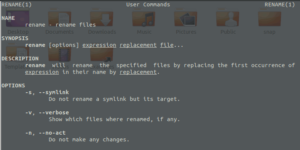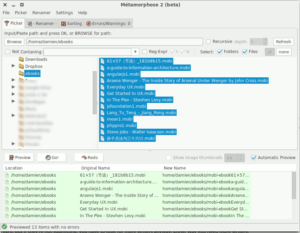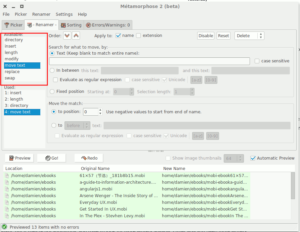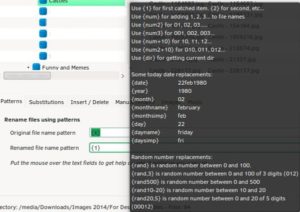If you’re searching for information on How to Rename Files in Linux, you’ve come to the right source. Today, I will share an incredible method with you. Typically, renaming files is not a highly complicated task and usually doesn’t require specialized tools unless you’re dealing with a small number of files. However, if you have a large collection of pictures from last year’s holiday that require renaming, it’s worth considering time-saving strategies and applications to simplify the process.

The batch file renaming can be achieved either through command-line control or via a separate program. There are two general approaches. Linux users know how effective the CLI can be already, so there should be no shock that several file-renaming commands are open. you can also check out the WonderFox DVD Video Converter 18 Licence Key.
How to Rename Files in Linux with “mv” Command
Table of Contents
The mv command (shortened from “move”) is a simple way to modify files and folders. The primary function of this program is to transfer and change data and folders because the naming is defined as transferring a file from one name to the next.
The following syntax is used to rename files with mv:
mv (option) filename1.ext filename2.ext
“filename1.ext” is the original, “old” name of the file, and “filename2.ext” is the new name.

The same pattern works for folder renaming. If the files are not located in the currently active folder, their full path has to be specified:
mv /home/user/Files/filename1.ext /home/user/Files/filename2.ext
Notice that for the folder containing files, the mv command needs to write authorization. For device files and folders, the user should be able to rename the files by prepending mv with sudo or su to get root permission. The-i (interactive) alternative offers a further security layer that allows the consumer to validate the rename of the file before it is actively used.
There is also the alternative -v (verbose) listing all the changes made by mv. Options are written before filenames after mv not before.
Using the “rename” command
This order is slightly more advanced than mv because it requires regular expression awareness or at least basic familiarity. This may sound scary, but don’t give up renaming – it can be used just by following tutorials like this one for batch renaming.
The rename the syntax looks like this:
rename (option) 's/oldname/newname/' file1.ext file24.ext
The letter “s” stands for “substitute,” and it’s the main part of the regular expression. Single quotes around it are obligatory. Available options are:
-v(verbose: prints the list of renamed files along with their new names)-n(“no action:” a test mode or simulation which only shows the files that will be changed without touching them)-f(a forced overwrite of the original files)
The rename the command also accepts wildcards to rename multiple files of the same type, and it works on file extensions as well. For example, this would change all files with the extension .jpeg to .jpg:
rename 's/.jpeg/.jpg/' *
The wildcard symbol (*) means that all files in the folder will be affected.
The regular expression also has its own options (modifiers): “g” (global; affects all occurrences of the expression), and “i” (performs case-insensitive substitution). They are written at the end of the expression just before the closing single quote and can be combined:
rename -n 's/DSC/photo/gi' *.jpg
The command would also modify the portion of the filename to “photo.” But, because of the option “-n, “the command would not rename the file but just display them in the console window. This will be applicable in the files” DSC,” “dSC “and” dsc “This will occur.
The only thing that this common phrase can do is not a replacement. There’s also a conversion–labelled with a “y” dot–that can render the filenames more complicated. The case file name is most commonly changed:
rename 'y/a-z/A-Z/' *.jpg
That will shift the name to uppercase for all jpg files. To do so and vice versa, just alter the standard expression’s “old name” and “new name.”
To achieve the desired result, the rename command combines a few simple patterns. The “-n” option allows users to never jeopardize their data (or their nerves) since it gives a secure and usable overview of how they’re called.
Métamorphose2
A cross-platform script and mass-replacer archive is Métamorphose. Métamorphose is a very powerful tool to use for those who want an Interface application for renaming transactions. It’s both Windows and Linux accessible.
Go to its website to launch and download your Distro Installer Set. It includes a deb file for Fedora, Mandriva, and SUSE for Debian-based distro and RPM kit. Only in Arch Linux, it is usable in AUR.
It is the first “picker” tab when you launch the device. You pick the directory with the files that you want to delete. Please note that the rename process allows only one directory at a time, but it provides access to child directories within the selected directory.

Click on the “Renamer” tab when you pick the page. You can choose the renaming rules from here. The operation you want to execute on the left panel can be picked. For instance, “insert” incorporates words into the name while “length” allows a number of characters to trim the files’ names. You can also pick the’ jump file,” turn’ and’ shift.’ As you can see, you can rename your files with comprehensive choices.

Lastly, just click the “Go” button at the top of the bottom pane to run the renaming action. If you find any error after renaming, there is an Undo option to revert all the changes.
pyRenamer – the easy way out
And lastly, the answer waited for by all anti-console users: a desktop application that can do these tasks with a single mouse button. PyRenamer is a crazy, efficient Python-written device to rename directories. Right now, Ubuntu users and its descendants are obviously still free to install py renamed from repositories using the command:
sudo apt-get install pyrenamer

The interface consists of four parts:
- a tree-view file browser for selecting files and folders
- a central preview pane showing the filenames before and after renaming
- a tabbed control area for choosing the renaming criteria
- the Options sidebar
Effortlessly Modify and Organize Filenames with PyRenamer
PyRenamer may delete accents and symbols from filenames, change any text string to another, modify the filename to uppercase, lowercase or sentence case and insert or erase spaces and underscores automatically. Pressing Rename in the tab-box section allows beginners to easily select everything and preview it in the main area. PyRenamer can provide you with a cheat sheet to make it easier to play with patterns.

Advanced users can enjoy the ability of pyRenamer to rename multimedia files by reading metadata. You can also rename a single file manually if it is impractical to rename a series.
Basically, py renamed folds the mv code into a user-friendly Interface and eliminates orders. For people who do not believe in their CLI abilities, that is a great choice.
There are, of course, many ways of changing Linux files–for example, by writing a script or using other py renamed-similar tools.
How to Rename Files and Directories in Linux
One of the most critical activities you often require in a Linux environment is renaming the files and directories. Using a GUI file manager or via the command-line console, you can rename data.
Renaming a single file is simple, but it can be a difficult challenge to rename multiple files at once, especially for users new to Linux.
This guide teaches you the way to delete files and folders using the mv and rename commands.
Renaming Files with the mv Command
The mv command (short of move) is used to rename or move files from one location to another. The syntax for the mv the command is as follows:
mv [OPTIONS] source destination
The source can be one or more files or directories and destination can be a single file or directory.
- If you specify multiple files it must be a directory. In this case, the files will go to the target directory.
- If you specify a single file, and the
destinationtarget is an existing directory; then the file is moved to the specified directory. - To rename a file, you need to specify a single file as a
sourceand single file as adestinationtarget.
For example, to rename the file file1.txt as file2.txt you would run:
mv file1.txt file2.txtRenaming multiple files with the mv Command
The mv a command can rename only one file at a time, but it can be used in conjunction with other commands, such as find or inside bash for or while loops to rename multiple files.
The following example shows how to use the Bash for loop to rename all .html files in the current directory by changing the .html extension to .php.
for f in *.html; do
mv -- "$f" "${f%.html}.php"
done
Let’s analyze the code line by line:
- The first line creates a
forloop and iterates through a list of all files edging with.html. - The second line applies to each item of the list and moves the file to a new one replacing
.htmlwith.php. The part${file%.html}is using the shell parameter expansion to remove the.htmlpart from the filename. doneIndicates the end of the loop segment.
Here is an example used mv in combination with find to achieve the same as above:
find . -depth -name "*.html" -exec sh -c 'f="{}"; mv -- "$f" "${f%.html}.php"' \;
The find the command passes all files ending with .html in the current directory to mv one by one using the -exec option. The string {} is the name of the file currently being processed?
As you can see from the examples above, renaming multiple files using the mv a command is not an easy task as it requires a good knowledge of Bash scripting.
Renaming Files with the rename Command
The rename a command is used to rename multiple files. This command is more advanced than mv as it requires some basic knowledge of regular expressions.
There are two versions of the rename command with different syntax. In this tutorial, we will be using the Perl version of the rename command. If you don’t have this version installed on your system, you can easily install it using the package manager of your distribution.
- Install
renameon Ubuntu and Debiansudo apt install rename - Install
renameon CentOS and Fedorasudo yum install prename - Install
renameon Arch Linuxyay perl-rename ## or yaourt -S perl-rename
The syntax for the rename the command is as follows:
rename [OPTIONS] perlexpr files
The rename the command will rename the files according to the specified perlexpr regular expression. You can read more about Perl’s regular expressions here.
The following example will change all files with the extension .html to .php:
rename 's/.html/.php/' *.htmlYou can use the -n option to print names of files to be renamed without renaming them.
rename -n 's/.html/.php/' *.htmlThe output will look something like this:
rename(file-90.html, file-90.php)
rename(file-91.html, file-91.php)
rename(file-92.html, file-92.php)
rename(file-93.html, file-93.php)
rename(file-94.html, file-94.php)
By default, the rename command doesn’t overwrite existing files. Pass the -f option to allow existing files to be overwritten:
rename -f 's/.html/.php/' *.htmlBelow are a few more common examples of how to use the rename command:
- Replace spaces in filenames with underscores
rename 'y/ /_/' * - Convert filenames to lowercase
rename 'y/A-Z/a-z/' * - Convert filenames to uppercase
rename 'y/a-z/A-Z/' *
Conclusion
We’ve shown you how to use the mv and rename commands to rename files.





